Body worn video
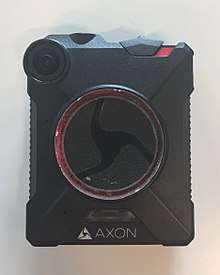
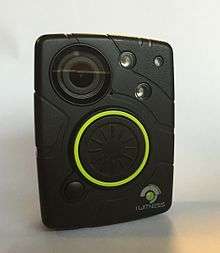

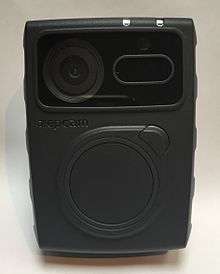
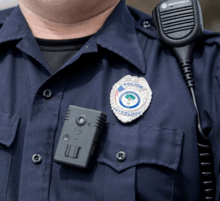
Body worn video (BWV), also known as body cameras and body-worn cameras, or wearable cameras is a wearable audio, video, or photographic recording system.
Body worn video has a range of uses and designs, of which two well-known uses are Google Glasses and as a part of policing equipment. Other uses include action cameras for social and recreational (including cycling), within commerce, in healthcare and medical use (for example as a memory prosthetic for conditions that affect the memory[1]), in military use, journalism, citizen sousveillance and covert surveillance.
Nascent research on the impact of body-worn cameras in law enforcement shows mixed evidence as to the impact of cameras on the use of force by law enforcement and communities' trust in police.[2]
Designs
Body worn cameras are often designed to be worn in one of three locations: on the torso, on or built into a helmet, and on or built into glasses. Some feature live streaming capabilities while others are based on local storage. The National Criminal Justice Technology Research, Test, and Evaluation Center is conducting surveys on the body worn cameras to help assist Law Enforcement in purchasing the best quality camera they will use. The survey goes over device functionality, optics, audio, GPS, and several more categories.[3]
Some of the leading companies in the police body camera industry are Wolfcom, Axon, Vievu, and Vidcie. Each has different camera designs, but all cameras tend to be about 3 inches. Axon's model includes two components: a button which the officer has to double click to start filming and a penny sized camera, which attaches to any type of gear such as safety glasses or an officer's collar. The double-clicking mechanism makes sure officers don't accidentally turn it on. Vievu and Vidcie's camera have sliders to turn the camera on, and officers mount it onto their chest. Axon's and Vievu's cameras must be turned on to activate them and turned off when filming is done. Vidcie's camera is used as a live stream that relays video directly to the precinct. These cameras range in price from 129 dollars to 900 dollars.[4]
Applications
Law enforcement
Wearable cameras are often utilized by law enforcement in several countries to record their interactions with the public or gather video evidence at crime scenes.[5][6] It has been suggested to increase both officer and civilian accountability, although arguments have been made that BWVs primarily protect police.[7] Because traumatic events may have an effect on memory, the cameras also allow video playback in the case of memory loss.[8] The first generation of 'modern' police body cameras was introduced around 2005 in the United Kingdom. Over $24 million has been given to police departments all across the United States to put toward the implementation of body cameras. This is to further reduce police brutality and public inquiry.[9]
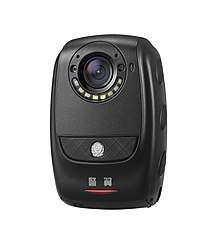
In recent years, body-worn cameras have been praised by many as a valuable asset for reviewing cases of police misconduct, more so than preventing it.[10] The NYC Civilian Complaint Review Board (CCRB) has on occasion used body cam footage to settle cases in which the integrity of officer and witness testimonies do not match. In an analysis of allegations of misconduct over the last five years, the CCRB reports that video recordings help the investigators make clearer determinations of misconduct than in cases that lack video evidence. However, much of this footage is not recorded by body-worn cameras, but rather CCTV footage and civilian recordings. The current amount of video footage available from many sources is substantially increasing the CCRB’s ability to resolve cases involving officers. In the years 2014 to 2017, the CCRB has been able to close on average approximately 20% more cases with video evidence than without.[10]
Early research based on pilot projects has sometimes shown significant positive results. But the first meta-evaluation that was published in 2014 warned that more research is needed. This meta-evaluation was based on five evaluations from body camera projects in the United Kingdom (Plymouth 2007 and Renfrewshire/Aberdeen 2011) and the United States (Rialto, Mesa and Phoenix – all published in 2013). Most of these studies documented a reduction in complaints against the police and, in some cases, similar reductions in use of force and assaults on officers. However, most of these evaluations had 'significant methodological limitations', for instance no comparison group or no independent evaluation.[11]
Later studies showed conflicting results. In a large-scale study in London from 2015, involving 2,000 police officers, complaints related to interactions with the public reduced, but not to the point of statistical significance. There was no impact on the number of stop and searches conducted, no difference in officers' self-reported behavior relating to how they conducted stops, no effect on the proportion of arrests for violent crime and no evidence that the cameras changed the way police officers dealt with victims or suspects.[12] A 2017 study from Washington, D.C. including a large number of law enforcement officers showed no effect of body cameras on documented uses of force and civilian complaints, or on a variety of additional policing activities and judicial outcomes. The authors suggest 'we should recalibrate our expectations' of body-worn cameras: "they may have great utility in specific policing scenarios, but we cannot conclude from this experiment that they can be expected to produce large, department-wide improvements in outcomes".[13]
In reviewing the existing research on police body-worn cameras in 2017, University of Virginia economist Jennifer Doleac noted that the existing research was mixed as to whether the cameras reduce the use of force by police officers or increase the communities' trust in police.[2][14] But a reduction in complaints against police using excessive force does not necessarily mean there are fewer cases of misconduct, it could mean that people are just not speaking up or the body camera was not tuned on and the footage cannot be investigated. More time and research will allow a more precise answer to whether or not body worn cameras improve officer conduct.[15] An analysis by the San Antonio Express-News of San Antonio law enforcement's use of body-worn cameras found that incidents where police used force and formal misconduct complaints decreased significantly; scholars of crime were unsure to what extent body-worn cameras played a role in the decline, but noted that the results were consistent with trends in other cities were cameras have been introduced.[16]
Howard M. Wasserman has identified several other limitations. Adopting body worn video can have unintended outcomes. In particular, increased transparency can create over-deterrence: when officers know they are being recorded, they will only do the minimum required. Another limitation is the video evidence. Video doesn’t always ‘speak for itself’ and there will still be different opinions on certain videos due to their ambiguity. In addition, departments must address multiple issues about the deployment and use of body cameras. One survey shows “It offers more than 30 recommendations of protocols for using cameras, recording events, and storing, reviewing, identifying, using, and releasing a potentially enormous volume of recordings.” These are major barriers to fully implementing body worn video. Wasserman states that “body cameras must reflect the nuance and complexity of camera policy, grounded in the limitations of video evidence and the hard questions of implementation,” so we cannot jump to conclusions with our expectations of body worn video.[17]
As police departments increasingly implement body-worn cameras, the issue of failing to turn them on has also arisen. Actions have been introduced and viewed in the courts brought up by unions in such case of the ‘Boston Police Union’. As cameras become more of the standard, officers voiced possible apprehensions of department supervisors and uses as a way of the conduct review.[18] As of July 2017, only 10% of police shooting fatalities in the U.S. had been recorded by body-worn videos for that year. Various other investigations have found shockingly low numbers of footage recorded as compared to the amount of time officers were on duty.[19] Studies show acceptance of the relatively new technology by officers is a problem where privacy is concerned. There are fears that the body-worn cameras may capture private conversations and result in the unintended footage being used in court or for corrective action by superiors. Boston Police Commissioner William Evans said in an interview that he is concerned that by implementing body worn video citizens will feel less inclined to notify officers of potential crime.It is possible bystanders will withhold valuable information due to fear of being on camera.[20] Other factors that lead to low use have been shown to be based on officer demographics such as the officers age, gender, or years of service.[21]
Another concern for law enforcement is storage costs. With many state and local police departments in the U.S. purchasing body-cameras for their officers, storage of the videos is becoming an obstacle. Because departments in larger cities can generate body cam footage in excess of 10,000 hours a week, some of these agencies are utilizing cloud-based high-volume storage facilities.[22] Storage costs are not the only concern, but the security of the data becomes a real challenge, protecting the data from intruders (hackers).[23]
Recorded Digital Data and the Judicial System
The courts will be faced with a whole new set of challenges of the recorded data, like: Do the courts have the resources to go through the recordings needed for a case? How will this material be presented to the jurors? New guidelines, practices and procedure will need to be in place to protect those who were captured on the video, mainly innocent bystanders/witnesses who were not involved incident, how will their privacy rights be protected?[23]
Military combat
Body worn cameras, as well as helmet cameras are used to document military combat.[24]
Privacy concerns
Concerns over privacy have been raised with this technology, for example in the context of both Google Glasses and policing.
Although this equipment has benefits in certain situations, the advent of large-scale data collection concerns, combined with facial recognition and other technologies capable of interpreting videos in bulk, means that any use of such cameras potentially creates a means of tracking much of the population at any time or place where other people may go.
In policing, every police officer wearing this technology could become a "roving surveillance camera"[25] and with facial recognition technology, this could become a huge impact on people's everyday lives, especially those with any slight resemblance to a wanted fugitive or terrorist. This can lead to not only an increase in police harassment cases but racial bias cases as well. There are also issues concerning party consent laws.[26] In the context of recording, the biggest issues arise from whether consent from one or all parties is required before recording a conversation or interaction.[27] Federal and individual states have varying statutes regarding consent laws. The nature of police work has officers interacting with the public during their most vulnerable moments,[28] such as those in the hospital, or domestic violence cases, as well as a threat of people not coming forward with tips for fear of being recorded. And in terms of the police officer's private contexts, they may forget to turn off cameras in the bathroom or in private conversations. These situations should be considered as the technology is developed further and the use of it is becoming more saturated. Departments will need to work with advocacy groups like the American Civil Liberties Union to develop policies that balance citizen's Fourth Amendment rights with the public's desire for transparency.[28]
See also
References
- ↑ Visual Memory Prosthetic, 1996
- 1 2 "Do Police Body-Worn Cameras Reduce the Use of Force? | Econofact". Econofact. 2017-11-17. Retrieved 2017-11-18.
- ↑ "Body Worn Camera Technologies Market Survey". The Federal Register / FIND; Washington. 81. 2016 – via public health database.
- ↑ Li, Shirley. "The Big Picture: How Do Police Body Cameras Work?". The Atlantic. The Atlantic Monthly Group. Retrieved 30 May 2018.
- ↑ Bayley, David H.; Stenning, Philip C. (2016). Governing the Police: Experience in Six Democracies. Transaction Publishers. ISBN 1412862310.
- ↑ Hung, Vivian; Babin, Steven; Coberly, Jacqueline. "A Market Survey on Body Worn Camera Technologies" (PDF). The Department of Justice's National Institute of Justice. Johns Hopkins University Applied Physics Laboratory.
- ↑ Pelt, Mason. "Do police body cameras protect the public?". siliconangle.com. SiliconANGLE. Retrieved 5 November 2015.
- ↑ Cubitt, Timothy. "Body-worn video: A systematic review of literature". Retrieved 3 September 2017.
- ↑ Gimbel, V. N. (2016, August). "Body cameras and criminal discovery". Georgetown Law Journal. 104 (6), p. 1581+. Retrieved April 27, 2018.
- 1 2 Wiley, Maya. "Body Cameras Help Everyone- Including the Police". Time. Time Inc. Retrieved 30 May 2018.
- ↑ White, Michael D (2014). "Police Officer Body-Worn Cameras: Assessing the Evidence" (PDF). Washington, DC: Office of Community Oriented Policing Services. Retrieved 3 September 2017.
- ↑ Grossmith, Lynne; Owens, Catherine; Finn, Will (2015). Police, Camera, Evidence: London’s cluster randomized controlled trial of Body Worn Video (PDF). London: College of Policing.
- ↑ Yokum, David (2017). Evaluating the Effects of Police Body-Worn Cameras: A Randomized Controlled Trial (PDF). Washington D.C.: The Lab@DC.
- ↑ Doleac, Jennifer L. (2017-10-25). "Do body-worn cameras improve police behavior?". Brookings. Retrieved 2017-11-18.
- ↑ "Considering police body cameras". Harvard Law Review/LegalTrac. April 2015. p. 1794. Retrieved January 25, 2018.
- ↑ "In San Antonio, body-worn cameras on police appear to be cutting complaints". Houston Chronicle. Retrieved 2018-02-23.
- ↑ Wasserman, Howard (2015). "Moral Panics and Body Cameras". Washington University Law Review. 92 (3): 831–843. Retrieved 30 May 2018.
- ↑ "Body-worn police cameras: separating fact from fiction: a look at [5] important claims about the technology". link.galegroup.com. Retrieved 2018-01-27.
- ↑ "Officers, turn on your body cameras". The Washington Post. 2017-07-22. ISSN 0190-8286. Retrieved 2018-02-02.
- ↑ http://ky5ry5jk2j.search.serialssolutions.com/?ctx_ver=Z39.88-2004&ctx_enc=info%3Aofi%2Fenc%3AUTF-8&rfr_id=info%3Asid%2Fsummon.serialssolutions.com&rft_val_fmt=info%3Aofi%2Ffmt%3Akev%3Amtx%3Ajournal&rft.genre=article&rft.atitle=Current+events+and+new+funding+options+fuel+growth+of+body-worn+video&rft.jtitle=Securityinfowatch.com&rft.date=2015-05-01&rft.pub=Cygnus+Business+Media&rft.externalDBID=XI7&rft.externalDocID=A413800565¶mdict=en-US
- ↑ Obasi, Jonah (2018). "Police Officers' Perceptions of Body-Worn Camera Technology". Walden University ScholarWorks.
- ↑ Sanburn, Josh (January 25, 2016). "Storing Body Cam Data is the Next Big Challenge for Police". Time. Retrieved 2018-02-02.
- 1 2 Convey, Russell Dean (2017). ""Surveillance Keeps Us Safe, Even from the Police."". Privacy and Security in the Digital Age: 132–135 – via GALE|CX7251600030.
- ↑ Bud, T. K. (2016). The Rise and Risks of Police Body-Worn Cameras in Canada. Surveillance & Society, 14(1), 117-121.
- ↑ Tilley, Aaron. "Artificial Intelligence Is Coming To Police Bodycams, Raising Privacy Concerns". Forbes. Retrieved 2017-03-03.
- ↑ "How Police Body Cameras Work". HowStuffWorks. 2015-06-12. Retrieved 2017-03-03.
- ↑ "Recording Phone Calls and Conversations | Digital Media Law Project". www.dmlp.org. Retrieved 2017-03-03.
- 1 2 "Police Perspective: The Pros & Cons of Police Body Cameras". www.rasmussen.edu. Retrieved 2017-04-16.
External links
| Wikimedia Commons has media related to Body worn video. |
- Tanner S., Meyer M., Police work and new 'security devices' : a tale from the beat. Security Dialogue, 46 (4), 2015: 384-400.
- Police Body Cameras: What Do You See?. The New York Times.